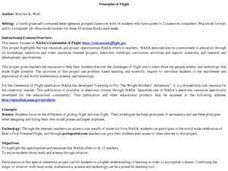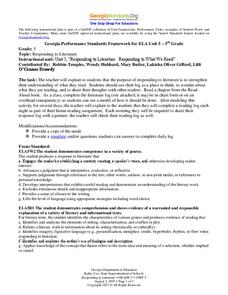Curated OER
Tuesdays with Morrie: Question-Answer Relationships
As part of their study of Mitch Albom's Tuesdays with Morrie, class groups examine passages from the story and respond to a series of QAR questions.
Curated OER
The Sun Also Rises: Vocabulary
After researching the etymology of a word from the provided The Sun Also Rises vocabulary list, kids employ the desk top strategy and teach their word to other class members.
Illustrative Mathematics
Extending the Definitions of Exponents, Variation 1
Scientist work with negative integer exponents all the time. Here, participants will learn how to relate negative exponents to time and to generate equivalent numerical expressions. Learners will apply the properties of integer exponents...
Illustrative Mathematics
Global Positioning System II
Intricate details of a modern technology that many of us take for granted in our phones, computers (and some cars) are laid bare in a short but deeply investigative activity. The math behind a seemingly simple GPS device...
Curated OER
Create A 3-D Community Model
Students listen to a short story and take notes on the details. Using a graphic organizer, they state what makes up their community. They create a 3-D piece of art that tells someone something about their community. They share them...
Curated OER
Multi-Choice Elementary
In this ESL vocabulary building activity, students analyze 7 pictures of common objects as well as pictures that show location of a ball in relation to a box. Students answer 7 multiple choice questions about the pictures.
Curated OER
Closed Economy Expenditure Model Test
In this economics worksheet, students answer questions relating to consumption, investment, and expenditures in a model of a closed economy. The eight page worksheet contains forty multiple choice questions. Answers are not...
Curated OER
My Spacecraft Model
Students work together to develop their own model of a spacecraft. They complete illustrations and writings to document their work. They present their information to the class.
Curated OER
Math: Who Makes an Epidemic?
Young scholars calculate the threshold value for the number of susceptible people needed to create an epidemic. They examine a real life flu epidemic and use the SIR model to solve the problems. Students discover they can use...
Curated OER
Duh! It's D!
Students master the formation and phonetic sound of the letter "d" in this lesson. They are introduced to the sound of the letter "d" and practice writing it to place in their individual alphabet books. The students listen to the book...
Curated OER
Piece of the Sky: Introduction for Making S'COOL Observations
Students observe and discuss cloud cover. They identify percent of cloud cover, calculate cloud cover by fraction and convert to a percent, and compare their models with the current real sky cloud cover.
Curated OER
Groundwater Modeling
Students evaluate the effects of point and non-pointy sources of water pollution using a model. They assess human impact on water quality. Students build a model which represents an aspect of the hydrosphere and compare their model with...
Curated OER
Wetlands/Watershed Model
Students work together to create a watershed model. They discover the flow of surface water on different topography. They examine how materials originate from miles away and end up in a different wetland.
Curated OER
Mathematical Models with Applications: What's Your Rate of Change?
Students use regression methods available through technology to select the most appropriate model to describe collected data and use the model to interpret information. They use numeric techniques to write the equation of a line that...
Curated OER
Three D Constellations
Young scholars are introduced to both celestial coordinates and to the first rung on the distance determination ladder. They convert spherical coordinates to Cartesian coordinates to construct a three dimensional model of a...
Curated OER
polyhedron
Students examine the different types of polygons and their characteristics. In this polyhedrons lesson, students discuss the derivations of specific models of polyhedrons. Students work in pairs to make a copy of a polygon...
Curated OER
Two-Dimensional and Three-Dimensional Shapes
First graders explore 2-dimensional and 3-dimensional shapes. In this geometry instructional activity, 1st graders examine the attributes of 2 -dimensional and 3-dimensional shapes. They also create the shapes as they build models. This...
Curated OER
Three-Dimensional Play Dough
Fourth graders make models of three-dimensional figures and then use these play dough figures to observe and count the vertices, edges, and faces of the figure.
Curated OER
River Planning
Students use a model to conduct an experiment involving dam construction. Based on their observations, they draw conclusions about social, economic, and and environmental issues and make a decision concerning dam location. As a group,...
Curated OER
Creeping
Students observe, measure, and graph a model of slow down slope movement representing soil creep. This task assesses students' abilities to collect, record, and organize data, set up graph axes, plot data points, draw line graphs, apply...
Curated OER
Dayna Lykins, Leanna Prater
Fourth graders compare and contrast gliding flight and true flight. They investigate the basic principles of aeronautics. The class participates in activities to observe lift and the effect of air. Students design and fly their own...
Curated OER
Probing Under the Surface
Eighth graders use a measuring stick to determine the shape of the inside of the bottom of a box, then apply their knowledge to an additional situation. This task assesses students' abilities to make simple observations, collect and...
Curated OER
Responding to Literature
Fifth graders examine how to respond to literature. In this literature response instructional activity, 5th graders discuss how to respond to literature. They write a response in a literature log each night based on their reading and the...
Curated OER
What are the Kinds of Triangles?
Fifth graders classify triangles. In this triangle lesson, 5th graders learn about the characteristics that make up a triangle. They are instructed through video, PowerPoint slides, and teacher-led demonstrations.























